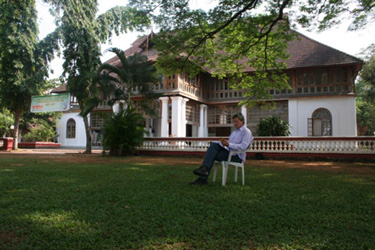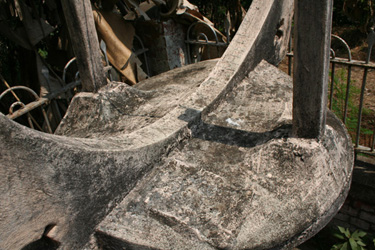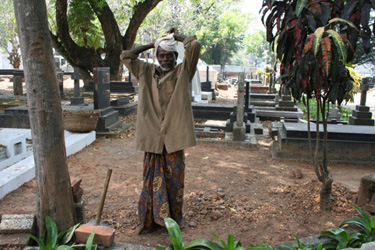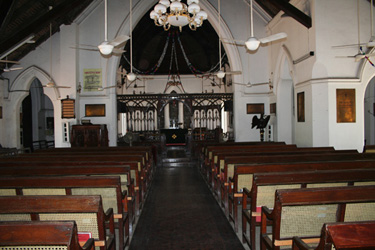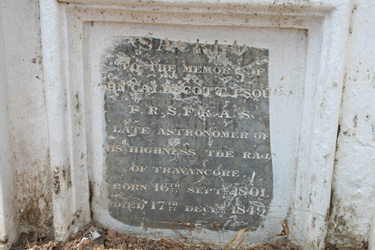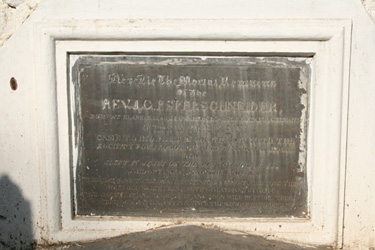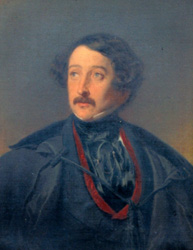
John Caldecott FRS
 |
Dr Richard Walding Research Fellow - School of Science Griffith University Brisbane, Australia Email: waldingr49@yahoo.com.au |
LINKS TO MY RELATED PAGES: Indicator Loops around the World (Home Page) How an indicator loop works
John Caldecott was born on 16th September 1801 in the parish of Finsbury, London, just a few miles to the north east of the city centre. He was christened 1 Nov 1801 at the family church - St Luke's Church in Old Street - but now demolished. His mother Susannah was 20 and his father John (Snr) was 31. By November 1818 the father (John Snr) had not succeeded in getting jobs for his elder sons John (Jnr) and William. John was one month too young to take an opening at Bank of England.
Little is known of John's activities in England at this time. He (John Caldecott) travelled to India in 1820 aboard the Mulgrave Castle, 460 tons, departing Gravesend 14 January 1821 and then via Madeira, Isle of France, The Cape, Ceylon and arrived in Bombay on 25th May 1821. He then began his employment as assistant to Daniel West at Apollo Cotton at Rs 200 per month plus £100 expenses. The West family was friends with the Caldecotts in London and had established a business in Bombay in 1909. One of the owners, William West - in 1815 - "began investigations in telescopes and microscopes as an evening amusement, a subject in which he took great interest ever after". This was later to interest John Caldecott.
For some years John travelled in India but with his home being mostly in Bombay working with Apollo Cotton. When the steeple of the Scottish Church in Bombay [St. Andrew's Kirk, in Marine Street, which was built in 1818] was struck by lightning in 1826 it was Caldecott who organised and supervised repairs. On 8 November 1825 he married Selina Darby at this church. His marriage began to fall apart and on 21 December 1827 his wife returned to England. By 1828 John's salary from various employments was now £800 pa taking the Rupee as 1s 8d. In October 1828 he took a voyage down the coast to Travancore (now Kerala, Southern India), to visit his friend Humphrey Owen at a coffee plantation at Alwaye near Cochin. When he returned he resigned from Apollo Cotton on 1st March 1829 and by April had entered a partnership with Owen under the title of Owen, Caldecott & Co. – formerly HF Owen & Co.
In August 1831 Caldecott was appointed Commercial Agent and Master Attendant at Alleppey as an employee of the Travancore Government in southern India. This was his first contact with the Church Missionary Society in southern India. He had met John Monroe, the former British Resident for Travancore and Cochin, at a CMS meeting while still in London (in about 1819). The erstwhile states of Travancore and Cochin have now been combined to form the modern state of Kerala. The minister at Cottayam (near Alleppey) Rev. Thomas Norton said "Mr Caldecott our new superintendent in place of Capt. Rorison called today. He manifested and expressed a strong desire to be on friendly terms. He appears to be agreeable. May God give him to receive the truth, and render him a blessing to the place".
Caldecott had a small bungalow at Alwaye (about 13 km NE of Cochin) that he used in the very hot months from April
to June. Here he built an observatory for his portable astronomical instruments.
Caldecott shared an interest in astronomy, in which he was self-taught, with
General Stuart Fraser, British government representative at Trivandrum, and
through Fraser was introduced in 1832 to Swathi Tirunal [Rama Vurmah], Raja of Travancore.
The Raja was a cultured man who had been educated in the English medium by
various tutors and was fascinated by
European scientific ideas. Caldecott would often instruct the Rajah's brother (Elija
Thirunal) in chemistry during the Elija's student years. Swathi Tirunal had visited Alleppey and inspected
Caldecott portable astronomical instruments. Caldecott suggested that a small
observatory be built at Alleppey but the Raja offered him a position as
astronomer at Trevandrum (Trivandrum) in a new observatory. Operations began using Caldecott's own portable
but substantial instruments: namely -
| 1. | (portable) altitude and azithmuth with 18" and 15" circles; (just arrived at Madras) | £150 |
| 2. | 30" transit (telescope) by Dolland | £84 |
| 3. | fine equatorial (telescope, mounted) by Troughton & Simms | £530 |
| 4. | Troughton & Simms reflecting circle (portable) | £84 |
| 5. | a 46" refracting telescope (mounted) | £140 |
| 6. | three chronometers | £60 each |
While the observatory was under construction Caldecott and Taylor undertook a magnetic survey of southern India, through which the magnetic equator passed, using second-hand instruments from previous surveys. T. G. Taylor had been collecting magnetic data at Madras since 26 April 1837. He departed Madras on 23 July 1837 to meet Caldecott at Tranquebar on 2 August 1837 to begin the magnetic survey continuing into 1838. Taylor collected data at Tranquebar on 3 Aug alone, then is joined by Caldecott at Tranquebar where they make joint observations (7, 8, 9 Aug 1837), Negapatam (13 Aug), Manargoody (same day, 13 Aug), Sheally, Pondicherry, Negapatam (13 Aug with JC), Poothocottah, (14 Aug), Munanamelegoody (15 Aug), Kalehennary (16 Aug), Ramuad (17 Aug), Carryshandy (20 Aug), Vadinatum (21 Aug), Powani (22 Aug), Pallamcottah (23 Aug), Nagracoil (25 Aug), Trivandrum (28 Aug, 5,13 Sep). Caldecottt (alone) makes observations at Calicut (Nov 4), Penaney (Nov 5), Chetwaye (Nov 6), Bolghatty (Nov 8), Allepee (12, 13 Nov), Quilon (15 Nov), Trivandrum (20 Nov).
There were some unsatisfactory outcomes of this survey due, in part, to defective instruments, but probably also to geological effects unrecognized at the time. At much inconvenience, Caldecott (alone) repeated his observations at Allepee and Cochin with a new needle (in a dip apparatus by T. Jones sent out to Madras from England), prior to his departure to Europe at Trivandrum, and made observations at the meteorological bungalow (15 Dec 1838); at Quilon in the Residency grounds in a mango tree 100 yds south of the house (15 Dec); at Allepee, in a thatched shed in Mr Anderson's compound south of the house (20 Dec); and finally at Balghatty in the Residency compound in a tent (21 Dec).
In late December 1838 Caldecott sailed for England via the Red Sea in a vessel of his own - 30 tons - to procure apparatus from the leading makers: namely, a 5 foot transit instrument by Dolland - £180; a transit clock from Thomas Jones £400; two mural circles of 5 ft diameter from Troughton and Simms at £750 each; an astronomical clock from Dent for £60; a powerful reflecting telescope (not sure of the cost but between £150 to £2500); a powerful achromatic refracting telescope (between £150 to £2500); various other items. On his way to London from India he passed through the Red Sea and arrived in Jeddah in March 1939, intending to visit Mecca in disguise but the Mohammadan who has arranged to accompany him failed in courage at the last moment and would not go. He stopped in Cairo and measured the height of the grand pyramid using Wollaston's Thermometrical Barometer as 458 feet. He travelled by steamboat from Alexandria via Syra and then was quarantined in Athens for 10 days. He finally made it to London on 2nd August 1839.
While in London he became aware of plans for a worldwide network of magnetic observatories, and obtained the Raja's consent to buy a set of magnetic instruments from Grubb of Dublin to match those being provided for the other British and East India Company observatories. On the 10th January 1840 he was Elected Fellow of Royal Astronomical Society and was present at the meeting with John Herschel in the chair. Proposers were Herschel, Bailey, Sabine, Beaufort, Lloyd. At the British Association for the Advancement of Science Annual Meeting at Glasgow in September he was present for a toast to Rajah of Travancore at the dinner on the last evening.
Caldecott sailed from England in the
autumn of 1840, pausing at Cadiz to visit the Spanish naval observatory at San
Fernando, and then the Cairo observatory, reaching Trivandrum in April 1841 a
few days after the arrival of the magnetic instruments which he had ordered. A
magnetic and meteorological observatory was constructed that year and a new
building for the 7 ft equatorial telescope went up in 1842. Taylor helped with
the erection of the two mural circles.
|
|
Author Dr Richard Walding, sitting in the grounds of Bolghatty Palace near Cochin (in the exact spot where Caldecott took several meteorological and magnetical measurements. |
Dr Richard Walding seated in Caldecott's chair in the Trivandrum Observatory (2007). |
Caldecott also corresponded with the Scottish scientist J. D. Forbes who was actively promoting experiments to measure deep-soil temperatures, following those made in France; he obtained from Adie of Edinburgh a set of thermometers 3, 6, and 12 French feet in length so that readings would be comparable with the French results. They were put into the ground near the observatory and the results, which were not extensive as one of the thermometers was soon broken, were communicated to the British Association.
Though not officially part of the international magnetic observatories network,
Caldecott assiduously met the same demanding schedule of observations, which he
returned to Edward Sabine at the Royal Society. Isolated, overworked, and
harassed by the ‘narrow-minded jealous fool of a Resident'—this was General Cullen, who had replaced the amiable
former resident, Foster—and receiving no acknowledgement of his flow of
observations and correspondence, he wrote bitterly to Sabine: "you have such
little idea of all I have to contend with … to keep scientific matters going
here, or I am sure you would be inclined to give me a helping hand … rather than
a silence now maintained for 12 months since I first commenced operations". His reward was a batch of
letters which had been delayed in transit, including one in which Sabine
complained about the excess postage which Caldecott's observations had incurred.
Caldecott was even more frustrated when the first abstracts published in England
ignored the data from Trivandrum (which Sabine may well have considered less
reliable than that from the nearby and official Madras observatory). Caldecott's
father John Caldecott (Snr) died, aged 74 years in 1844. He spent 50 years at
the Bank of England. His wife (Caldecott's mother) Susannah died 7 weeks earlier
aged 63 years.
 |
 |
| Dr Achuthsankar Nair (Kerala University) and Dr Richard Walding (Griffith University) inspect the Trivandrum meteorological and magnetical bungalow attached to the Trivandrum Observatory. As mentioned, Caldecott made observations here on 15 Dec 1838. | The observatory was designed by John Horsely of the Madras Engineers. Shown here is one of Horsely's other projects - the Karamana Bridge on the outskirts of Trivandrum. |
|
|
The sundial in the grounds of the Trivandrum Observatory |
Author inspects one of the early transit telescopes from Caldecott's time - the 7' equatorial. |
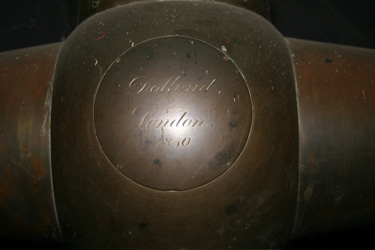 |
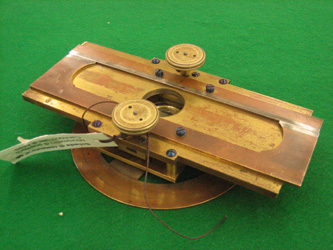 |
| Caldecott's 7 foot equatorial telescope by Dolland of London. Bought by Caldecott on his 1840-1841 European tour. | Amici's double-image micrometer used by Caldecott on his 7 foot equatorial telescope. ore information micrometer. You can read more at Alberto Meschiari's webpage: http://gbamici.sns.it/eng/strumenti/micrometro.htm |
He went to England in 1846 to seek the help of some scientific society to publish his observations, but in vain. He returned to Travancore in 1847; the raja undertook to publish the data and Caldecott was preparing this when he was taken ill. In January 1849 he travelled to Bombay and into the hills, seeking relief. In October he suffered a seizure, recovered, but fell ill on 8 December and was found dead on the morning of 17 December 1849. He left instructions in his will that his wife Selina should be maintained for her lifetime; his effects were then sold, his estate, as he had requested, divided equally between his two brothers William and George.
Caldecott's enthusiasm was no substitute for professional training. His results
were never published. His successor at the observatory, John Allan Broun, found
that the astronomical apparatus had not been properly installed, nor its errors
determined. The Indian assistants, less than scrupulous about their observations
in Broun's day, had probably grown lax during Caldecott's absences.
Nevertheless, the observatory stands as a great monument to the inspired
determination of Fraser, Caldecott and the Raja Swathi Tirunal - but also to
those to follow in the same century - Broun and Mitchell.
|
|
The grounds of the Christ Church, Trivandrum, where Caldecott was buried. John is shown here tidying the grounds. |
Inside Christ Church Trivandrum |
|
|
Caldecott's tomb at Christ Church. |
Buried next to acting Director of the Observatory while Caldecott was in England - Rev. Josiah Sperschneider. |
FAMILY OF
JOHN CALDECOTT - ASTRONOMER
My thanks to Dr David Atkinson, Whangarei, New
Zealand for his help in compiling this family tree.
Thomas Caldecott of Catthorpe, Leicestershire m Mary Prescott, had issue:
George Caldecott bt 1675 St Faith's under St Paul's, Paternoster Row, Middlesex, d 1708, Mercer merchant, m 9 May 1685 Sarah Wood, daug of John Wood b Essex, a London haberdasher, bt 1666 St Faith's under St Paul's, Paternoster Row, Middlesex, had issue:
Rev. George Caldecott, vicar of St Mary the Virgin, Great Bentley (1735-1763), Essex, bur 6 June 1763, m 17 Nov 1719 Fleet, London, Mary (Tayler?) bur 24 June 1764, had issue (the first four are only tentative, awaiting confirmation) :
Thomas Caldecott bt 8 Nov 1720 St Giles, Cripplegate
James Caldecott bt 17 Oct 1722, Kirkby, Underwood, Lincoln, England
George Caldecott b 2 Jan 1723, d 24 Jan 1723, 3 weeks, Tetney, Lincoln
George Caldecott bt 26 Apr 1725, Tetney, Lincoln
William Caldecott of Deptford b abt 1730 (see below)
Robert Caldecott bt 25 July 1735 Great Bentley, Essex
Mary Caldecott bt 21 Sept 1737 Great Bentley, bur 9 April 1754, age 16.
Sarah Caldecott bt 21 May 1739 Great Bentley
Adolphus Caldecott, bur 20 Feb 1797
Katherine Caldecott bur 31 Jan 1803.
William Caldecott of Deptford (an officer of the excise at Waltham Abbey) born abt 1730, d 23 Mar 1806, aged 76, married 27 Dec 1768 Frances Burgh, 3rd dau of John and Elizabeth Burgh (nee Pigbone), and sister to Elizabeth, Anne and Mary Burgh, had issue:
Frances Caldecott, b 1773, bap 7 Mar 1773, Essex, Waltham Abbey (spinster) - 1851Census living at Gothic Cottage, Lewisham, Kent 76 years old and living as a fundholder, died in March 1852 in Lewisham, Kent.
John Caldecott (Snr) of Blackheath Road, Greenwich, London, Kent, b 10 June 1770, died 2 July 1844 aged 74 years, Blackheath Rd, London; was with Bank of England for 50 years, married 25 Oct 1800 in presence of Frances Caldecott at Southwark Surrey, Susannah REDFARN (or REDHEAD) b 1 Oct 1779 baptised 25 Oct 1779 St Mary's Surrey, d 19th May 1844 (buried 25 May) Blackheath Rd, London. Residence 1841 Census Blackheath Rd, Union Place, London, Kent, Greenwich, age 60, independent means. Daughter of William Redfarn (son of William Redfarn buried 30 Oct 1770 and Sarah Redfarn (nee Palmer) m 8 March 1760 Parish of St Magnus the Martyr) and Susanna Redfarn married 1769 St Mary's Church, Newington, b 1739, d 1789, buried 28 May 1789 aged 50y; had issue:
A. John Caldecott, born 16 Sept 1801; christened 1 Nov 1801 St Luke's Church, Old St, Finsbury, Middlesex, London, d 16 Dec 1849, Trivandrum, Travancore. Royal Astronomer to the Raja of Travancore.
m(1) 8 Nov 1825, Bombay, Selina Darby, b 1808, eldest daughter of James Somerville Darby, Paymaster of the Queen's Royals.
m(2) 12 Feb (or Mar) 1835, Alleppey, Sophia Rodgers, b 3 March 1817, d Cochin,14th March 1836 aged 19 years & 11 days. Daughter of Joseph RODGERS, b. 23rd May 1787, Tanjore; d. 11 October 1851 (natural son of Major James Rodgers, of Madras Army & Military Auditor General of Ceylon; and Miss Julia LUCAS, b.13th May 1789, Madras; d. 6 Jan 1863, Cochin (natural daughter of Colly Lyon Lucas, Surgeon General of Madras).
B. William Caldecott, born 13 May 1803; christened 12 June 1803 St Luke's Church, Old St, Finsbury, Middlesex, London, d Mar Qtr 1864, Alderbury (Wilts). Lived at Deptford, Kent at time of marriage.
m 22 Aug 1829 at St Luke's Church, Curate Evan Morgan (witnesses were John Caldecott, groom's father, and Eliza Gaze) Hester WELLER of Lewisham Kent, bap 14 June 1809, St Mary's, Bromley, Kent; d 9 Nov 1876, age 66 (executors were her daughters Hester Susan and Katherine Sarah). Daughter of Timothy and Elizabeth WELLER. In 1837 he was living at George Place, Parish of Lewisham, Kent. In 1850 at time of brother John's death he lived at Frating Lodge, near Colchester, Essex.
(a) William Watson Caldecott (son), b 8 Sep 1830 New Cross Surrey, bap 6 Oct 1830 St Paul, Deptford, Kent, England Kent; died 4 June 1892 Hampshire London, aged 61. Corn and seed merchant.
married Susan Emily <surname>, b 1842 Colchester, Essex
(1) Ernest CALDECOTT, b 12 August 1863, Basingstoke, Hampshire. Married 10 April 1895 St John's Church Paddington London Edith Sara BAUER (25) born London dau of Adolphus William Bauer (gentleman). His son Douglas Neil Bauer m 1926 Ethelwyn May (Maisie) Barton Caldecott the dau of John Devon Caldecott. 1901 census: East Berks, Wokingham: Ernest (37), Edith (31) Mary C. (2) dau, b Berks. Ernest died aged 80 at Windsor in 1943.
(2) Minnie CALDECOTT, b 12 Mar 1865, Basingstoke, Hampshire, England
(3) Emily CALDECOTT, b 1870, Basingstoke, Hampshire, England
(4) Watson CALDECOTT, b 1871, Basingstoke, Hampshire, England, "son of William Walter Caldecott corn merchant, married 17 Aug 1899 Camden London at the Parish Church, Annie Louise DREW daughter of John Edward DREW father of both Ethelwyn girls. Watson d 16 Aug 1935 [1901 Census: 106 South Mortland St Marylebone, London: Watson (30) schoolmaster's assistant, b Hants; Annie Louise (nee DREW) (30) b London. Principal at Wolverhampton Grammar School, Middlesex, 1905-Feb 21st 1923 (salary £1000 pa) – see obituary The Times, Saturday, Aug 17, 1935; pg. 12]. Was 2nd Lt in WW1 then TempLt 4th Nov. 1916.
(5) Alfred CALDECOTT, b 1873, Basingstoke, Hampshire. 1991 census 2 Fairmile St Henley, Solicitor aged (27); wife Carrie L. (26)
(6) Lawrence CALDECOTT, b 1875 (Dec 1874), Basingstoke, Hampshire, England. In 1901census was living in Masters Cottage Bourne Avenue, Salisbury, Wiltshire with two colleagues Gilbert Harrwood (32) and Miles Sheldon Williams (23); In 1911 Teachers in Liverpool Schools: Relationship: Boarder, Single, Male, Age 36 (in1911), Born1875, Occupation Schoolmaster Elementary; Born Hants, Basingstoke, Address 56 Stanley St Fairfield; Occup: Science Teacher, Liverpool Collegiate School. BA, BSc (Science Master in 1920).
(b) Hester Susan Caldecott (dau) chr 1 July 1835, Kent, West Wickham, Kent, d Jun Qtr 1895 at Andover, aged 60 yrs.
(c) John Devon Caldecott (son) b 1834, d 10 Feb 1905
m Sept 1859 Greenwich, Eliza Sarah VERNEZ (elder dau of George Vernez (1800-11 Jan 1869) and Eliza Sarah THORN). Lived 19 London St, Andover, Hampshire.(1) John Barton CALDECOTT, b Dec 1861, d 14 May 1947 Sussex
m Middlesex, Ethelwyn Drew DREW b (St Lukes) Sep 1868 Kensington, Middlesex, dau of John Edward DREW.
Ethelwyn May (Maisie) Barton Caldecott (married 1926) Douglas Neil Bauer son of Adolphous William Bauer (who's daughter Edith Sara Bauer married Ernest Caldecott (son of William Watson Caldecott).
Hugh Devon CALDECOTT (13th DCO Lancers) m 1934 Mary Cecilia Riland BEDFORD (dau of Capt Christopher Bedford from Gloucester). Three sons only (identities removed from this and subsequent generations):o G
o R
o D
(d) Fanny Lynde Caldecott (dau) b Jun Qtr 1841, Kent, Lewisham, m 1867 at Andover, Thomas Ivers, b 1845, Eydon, Northamptonshire (Commercial Clerk).
(e) Katherine Sarah Caldecott (dau) b 6 Sept 1850, Essex, West Fraling. Was a domestic in 1861 census, and unmarried.
C. Susannah Caldecott, b 11 April 1805, baptized 13 May 1805, St Alphage, Greenwich, Kent, died (of Blackheath Road, dau of John Caldecott gent. and Susannah Caldecott) 9 Sept 1819, aged 14y..
D. George Caldecott, b early-mid June 1808, christened 16 July 1808, St Alphage Church, Greenwich, Kent, died 14 May 1837 (of Blackheath Road) aged 28. No record of marriage or children. Will dated 2 May 1837.
E. Hester Caldecott, b 1810, d Sep Qtr 1875 at Andover, aged 66 yrs.
TECHNICAL
How an indicator loop works
